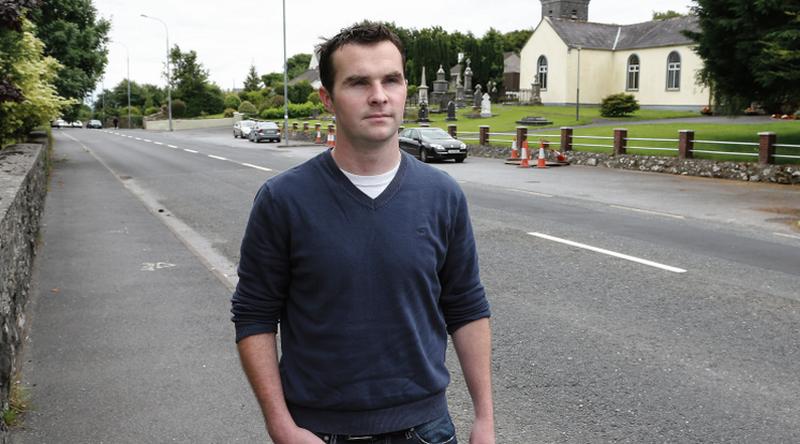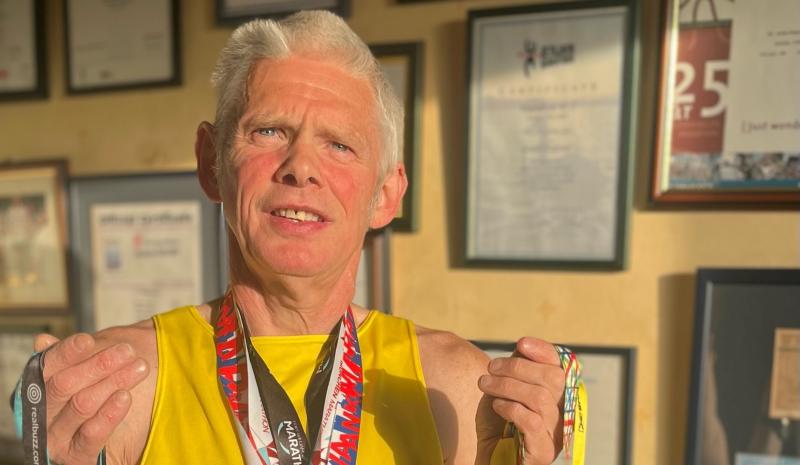Featured
Saved from the gallows: story of the reprieved

Lifestyle – Judy Murphy talks to author Colm Wallace whose new book tells the story of those who survived death sentences
When it came to reporting murder trials in the early days of the Irish State, newspapers didn’t hold back on gory details.
Plenty of these grisly contemporary reports are contained in a new book, Sentenced to Death: Saved from the Gallows, written by Renvyle man Colm Wallace. It charts the stories of people who were sentenced to hang in Ireland between 1922 and 1990, only to have their sentences commuted by the government.
Out of the book’s 30 cases, two are from Galway. One relates to a murder in Rosmuc in 1928, and the other deals with a 1943 murder in Bushypark in the city.
Colm got the idea of writing Sentenced to Death a few years ago when he read an article on the death penalty in Ireland – most people aren’t aware that it wasn’t abolished until 1990, he says, explaining that by then, it was reserved for those guilty of capital murder, such as killing a Garda or soldier. For other kinds of ‘common’ murder, it had been abolished in 1964. The last death sentence was passed in 1985, before Colm was born and was for the murder of Garda Sergeant, Patrick Morrissey in Co Louth.
Colm, a 28-year-old primary teacher, has always loved history. When he studied for his BA in Education at Mary Immaculate College in Limerick, his first-year subjects included history and German. He did Irish alongside education for his degree, because he loves Irish too, he adds. That came from his mother, Anne, who is originally from Baile na nGall in the Kerry Gaeltacht. Colm’s dad, Mark Wallace is from Renvyle where he’s very involved in GAA.
Twenty-nine people were hanged in Ireland before the death penalty was abolished in 1964 for ‘common’ murder, with the last hanging being carried out in 1954, says Colm.
He was fascinated by the stories surrounding these executions but a good deal had been written about them, so he turned his gaze elsewhere.
“I wondered what it would have been like to be sentenced to death and then told you had been reprieved,” he explains. “And there was very little information about that.”
So Colm, who had long been determined to write a book, decided to tackle that subject.
He began writing Sentenced to Death last July, treating the project like a 9-5 job and working every weekday through July and August, then every Saturday once he resumed teaching duties in Athenry.
The trial that really inspired him to explore the stories of commuted death sentences was that of Patrick Aylward from Kilkenny, who was sentenced to hang in 1923 for murdering a neighbouring infant, William Holden.
There was bad blood between Aylward and the Holdens and Aylward was accused of visiting the Holden house while their parents were away from home, and murdering the toddler by putting him in the fire. He strenuously denied any involvement in the child’s dreadful death, but the other Holden children gave graphic evidence to the contrary.
For more, read this week’s Connacht Tribune.
Connacht Tribune
West has lower cancer survival rates than rest

Significant state investment is required to address ‘shocking’ inequalities that leave cancer patients in the West at greater risk of succumbing to the disease.
A meeting of Regional Health Forum West heard that survival rates for breast, lung and colorectal cancers than the national average, and with the most deprived quintile of the population, the West’s residents faced poorer outcomes from a cancer diagnosis.
For breast cancer patients, the five-year survival rate was 80% in the West versus 85% nationally; for lung cancer patients it was 16.7% in the west against a 19.5% national survival rate; and in the West’s colorectal cancer patients, there was a 62.6% survival rate where the national average was 63.1%.
These startling statistics were provided in answer to a question from Ballinasloe-based Cllr Evelyn Parsons (Ind) who said it was yet another reminder that cancer treatment infrastructure in the West was in dire need of improvement.
“The situation is pretty stark. In the Western Regional Health Forum area, we have the highest incidence of deprivation and the highest health inequalities because of that – we have the highest incidences of cancer nationally because of that,” said Cllr Parsons, who is also a general practitioner.
In details provided by CEO of Saolta Health Care Group, which operates Galway’s hospitals, it was stated that a number of factors were impacting on patient outcomes.
Get the full story in this week’s Connacht Tribune, on sale in shops now, or you can download the digital edition from www.connachttribune.ie. You can also download our Connacht Tribune App from Apple’s App Store or get the Android Version from Google Play.
Connacht Tribune
Marathon Man plans to call a halt – but not before he hits 160 races

On the eve of completing his 150th marathon, an odyssey that has taken him across 53 countries, Loughrea’s Marathon Man has announced that he is planning to hang up his running shoes.
But not before Jarlath Fitzgerald completes another ten races, making it 160 marathons on the occasion of his 60th birthday.
“I want to draw the line in 2026. I turn 57 in October and when I reach 60 it’s the finishing line. The longer races are taking it out of me. I did 20 miles there two weeks ago and didn’t feel good. It’s getting harder,” he reveals.
“I’ve arthritis in both hips and there’s wear and tear in the knees.”
We speak as he is about to head out for a run before his shift in Supervalu Loughrea. Despite his physical complaints, he still clocks up 30 miles every second week and generally runs four days a week.
Jarlath receives injections to his left hip to keep the pain at bay while running on the road.
To give his joints a break, during the winter he runs cross country and often does a five-mile trek around Kylebrack Wood.
He is planning on running his 150th marathon in Cork on June 4, where a group of 20 made up of work colleagues, friends and running mates from Loughrea Athletics Club will join him.
Some are doing the 10k, others are doing the half marathon, but all will be there on the finishing line to cheer him on in the phenomenal achievement.
Get the full story in this week’s Connacht Tribune, on sale in shops now, or you can download the digital edition from www.connachttribune.ie. You can also download our Connacht Tribune App from Apple’s App Store or get the Android Version from Google Play.
CITY TRIBUNE
Galway ‘masterplan’ needed to tackle housing and transport crises

From the Galway City Tribune – An impassioned plea for a ‘masterplan’ that would guide Galway City into the future has been made in the Dáil. Galway West TD Catherine Connolly stated this week that there needed to be an all-inclusive approach with “vision and leadership” in order to build a sustainable city.
Deputy Connolly spoke at length at the crisis surrounding traffic and housing in Galway city and said that not all of the blame could be laid at the door of the local authority.
She said that her preference would be the provision of light rail as the main form of public transport, but that this would have to be driven by the government.
“I sat on the local council for 17 years and despaired at all of the solutions going down one road, metaphorically and literally. In 2005 we put Park & Ride into the development plan, but that has not been rolled out. A 2016 transport strategy was outdated at the time and still has not been updated.
“Due to the housing crisis in the city, a task force was set up in 2019. Not a single report or analysis has been published on the cause of the crisis,” added Deputy Connolly.
She then referred to a report from the Land Development Agency (LDA) that identified lands suitable for the provision of housing. But she said that two-thirds of these had significant problems and a large portion was in Merlin Park University Hospital which, she said, would never have housing built on it.
In response, Minister Simon Harris spoke of the continuing job investment in the city and also in higher education, which is his portfolio.
But turning his attention to traffic congestion, he accepted that there were “real issues” when it came to transport, mobility and accessibility around Galway.
“We share the view that we need a Park & Ride facility and I understand there are also Bus Connects plans.
“I also suggest that the City Council reflect on her comments. I am proud to be in a Government that is providing unparalleled levels of investment to local authorities and unparalleled opportunities for local authorities to draw down,” he said.
Then Minister Harris referred to the controversial Galway City Outer Ring Road which he said was “struck down by An Bord Pleanála”, despite a lot of energy having been put into that project.
However, Deputy Connolly picked up on this and pointed out that An Bord Pleanála did not say ‘No’ to the ring road.
“The High Court said ‘No’ to the ring road because An Bord Pleanála acknowledged it failed utterly to consider climate change and our climate change obligations.
“That tells us something about An Bord Pleanála and the management that submitted such a plan.”
In the end, Minister Harris agreed that there needed to be a masterplan for Galway City.
“I suggest it is for the local authority to come up with a vision and then work with the Government to try to fund and implement that.”












